Throughout his show, Blind Boy Paxton sang a variety of songs, spoke to us in between them or during them, exhibiting his quick wit and curious, joyous outlook on life. He's the real deal, y'all. Read a bio at the end of the post.
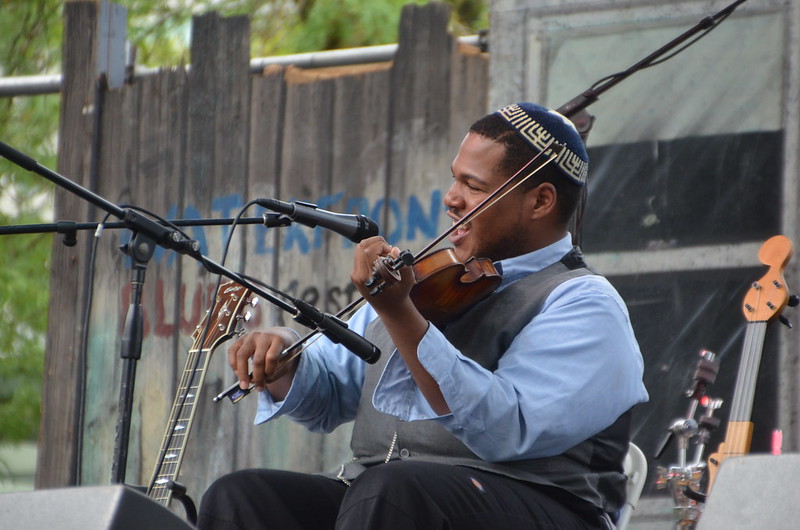
He played the fiddle. I took this photo at 3:40 p.m.
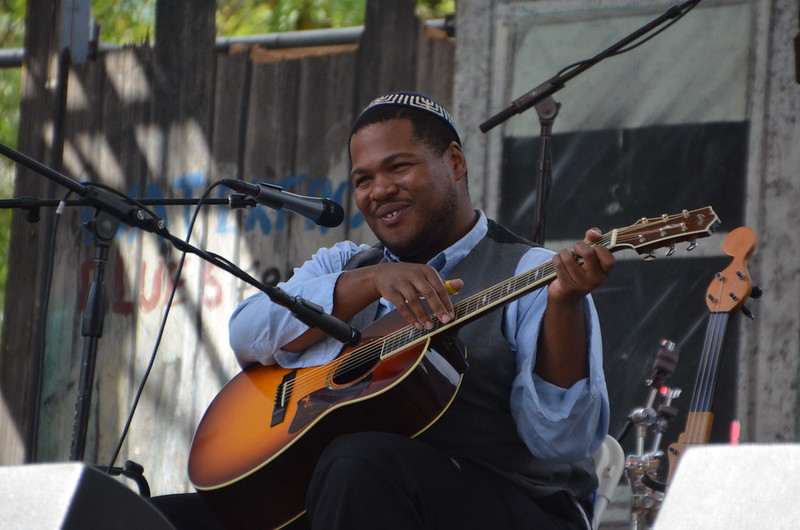
He played guitar. I took this photo at 4:08 p.m.
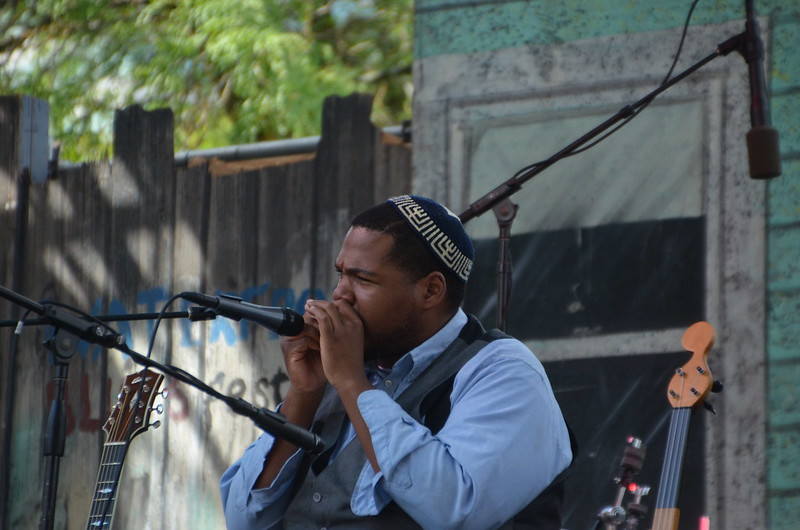
He played the harmonica. I took this photo at 4:15 p.m.
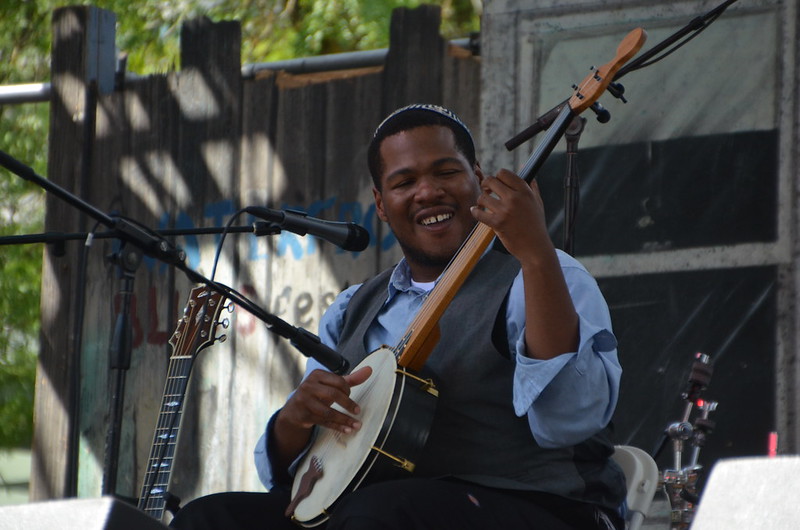
He played the banjo. I took this photo at 4:17 p.m.
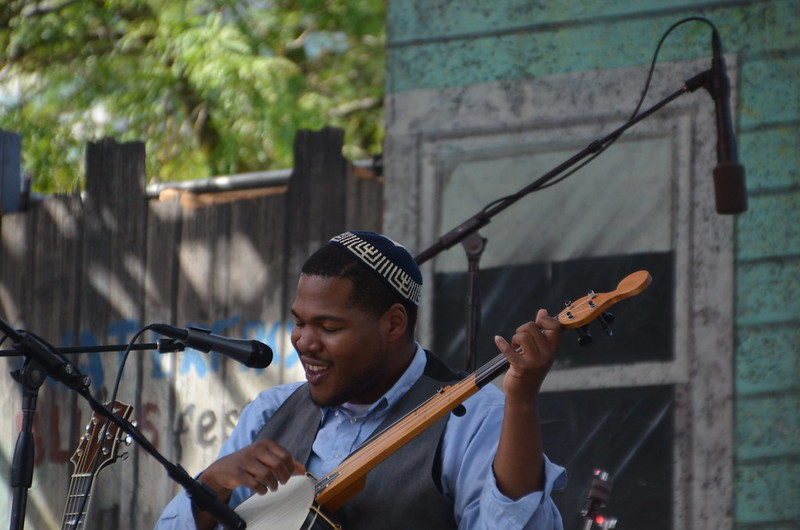
Here's the last photo that I took while Blind Boy Paxton entertained the crowd. I took this one at 4:32 p.m. Every second was the treat I knew it would be--I first enjoyed this young man's talents at the 2013 Safeway Waterfront Blues Festival.
Blind Boy Paxton's bio from The Country Blues Web site:
Meet Jerron Paxton, a modern day songster, minstrel and bluesman.
His name is Jerron (say Jer-Ron, giving it two distinct Rs) Paxton, but apparently you can call him “Blind Boy” if you want to.
Jerron Paxton is truly the living embodiment of the true blues in the 21St Century, but he plays it all in the true songster tradition: ragtime, hokum, old-time, French reels, Appalachian mountain music and blues and more – and whatever he plays sounds great .
The young bard was born in 1989, but his vast talent rivals the greatest in the genre. He is the whole package. He’s witty, fast rhyming, poetic, fun, exciting, wonderfully skilled as a musician and a fine singer, he is the continuation of a proud tradition, literally and figuratively. It’s hard to tell at times when Jerron Paxton, a consummate entertainer, is putting on an act, when he takes his act to real life and when life starts and the act ends. He seemingly appeals to audiences into the old-times look and sound, but it could also be, as he told the countryblues.com “I just like wearing overalls.” The artist has even reported to be the real-life son of Robert Johnson’s cousin. At first glance he looks like he’s playing the part of a bluesman in a Hollywood movie, dressed with theatrical retro-schtick, with some type of various hats, from Derbies to Orthodox Jewish kippa. The tall, corpulent young man almost looks like a young Willie Dixon, and he is smart to make hay when the grass is high, marketing himself directly to the segment of the blues community with a great nostalgic hunger for authentic musicians that accurately portray the image of the romanticized 1930s rural minstrel. It could be that for now, his closest local support group is the Jalopy Theater scene in Brooklyn, where there is an active old time community. For people who are bothered by the way Jerron Paxton, the real-life throwback to the old days, dresses on stage, the old adage applies “Don’t judge a book by its cover.” Let him dress the way he wants to. He knows what he is doing. All that matters is that he plays his heart out, and he is one smart young man.
Jerron Paxton comes across not as a young man in his early twenties , but he impresses with incisive understanding and wisdom far beyond his age. “I am a songster. I am not limited to the blues. I sing and play ballads, banjo tunes, fiddle tunes, rags and more.” he told thecountryblues.com. “For me, music is not an academic experiment. I play it the way I feel like it, because it should be an expression of how I see things. I am just learning to have a good time so that the audience can have a good time. Music shouldn’t be forced. It’s upsetting to me that so much music is technique, just skill and not enough feeling. I am happy to play so that the audience feels like I am in their living room. I want people to be enjoying themselves.”
Amazingly, he’s not just the real deal, he may be the most sensational newcomer in the blues in many years. In a good decade maybe a rare brilliant voice will emerge to ignite the acoustic blues world, a massive new talent to take helm the future of the traditional blues. John Hammond Jr.,Taj Mahal, Alvin Youngblood Hart, Corey Harris and Keb’ Mo’ come to mind as milestone movers and shakers in their respective decades. A fabulous new country blues talent as impressive as Jerron Paxton is not just rare, his extraordinary talent is almost surreal.” Top that with his unbridled freedom and range of repertoire , “I am not bound by what any record company has to say. I do whatever I want. I play it the way that I think it should be played.”
When Jerron Paxton gets on stage he breaks into a natural smile that carries through the entire performance. He exudes total happiness as someone who so evidently loves what he is doing, the audience is immediately encapsulated into his songs. There is a warm intimacy, a natural hearted love for what he is doing that simply engages the audience and create a connection. He calls it , “giving each audience member personal time.” In some way he is reminiscent of a young Louis Armstrong, a man who beamed from ear to ear not because he wanted to play nice to the audience, but because he had such fun. Jerron Paxton is having fun and so will you, with your own “personal time”.
He graces the cover of the Dec, 2012 issue of Living Blues, entitled “The Next Generation of the Acoustic Blues” with an amazing photograph by Bill Steber, who also authored the article.
Jerron Paxton has been blind since age 16,with peripheral vision problems that allow him some sight. He cannot drive and is legally blind, but has enough sight to get around and he can see enough to seem unaffected by his vision problems. People cannot immediately tell that he is blind, so they may falsely believe that he is putting on an act, but not so.
The charismatic songster bluesman, reports that he hails from an African American Jewish family with mixed Creole /Choctaw Indian ancestry – transplanted Louisiana sharecroppers who moved to South Central Los Angeles, but Jerron now lives in Queens. In other words, he is a true American.
He is a swiftly capable multi-instrumentalist who picks banjo and guitar, plays harmonica, piano and other instruments, including the fiddle, his first instrument. He is yet unsigned and his biggest fame has been found through the Playing for Change Foundation video II, which has catapulted him to international fame, just as it had done for slide guitarist Roberto Luti. All of this is peanuts compared to what is ahead for this remarkable musician who vividly and passionately recreates the original blues and is in many ways an uncanny songster.
The virtuoso is a joyous entertainer, humorous with a smooth vernacular, dazzling wit, a terrific storyteller, exuding an affable excitement. He told interviewer Peter Pantepinto, “All I do is play music; I’m too lazy to work.” The truth is, as he told thecountryblues.com, “When you grew up as poor as I did, all you had was family. I started formal music training when I was twelve, when my grandmother let me go to music school to learn the fiddle. Music is my chosen profession. Because of my vision issues, this is a good trade for me. That’s what I love doing. I intend to be successful in that.”
Jerron Paxton masters multiple blues styles and picks like Blind Blake. He feels home in the Piedmont tradition with its ragtime influence. Country blues fans will pick up on Blind Boy Fuller, Gary Davis, but also on the swampy blues of Louisiana and the Mississippi Delta. He digs deep in the archives of the country blues, from Furry Lewis to Texas Alexander. On the piano he can remind you of Fats Waller, although he cites James P. Johnson and Lucky Robinson as influences.. He is often cited to have said that at the age of fifteen– about the time he started to go blind– that he just didn’t like anything written after 1934. He raised himself on 78s. Sound familiar?
Clearly he is destined for greatness. Just give him a little time. He is very young and his career will ascend like a rocket. Phil Wiggins, harmonica ace, referred to Jerron Paxton as ” a musical genius.”
The young bard is actively touring and playing festivals nationwide. Keep your ears open for a CD which he says may come out in late Summer 2013, with his old friend Frank Fairfield. In the meantime, catch him on YouTube and download the few songs available online.